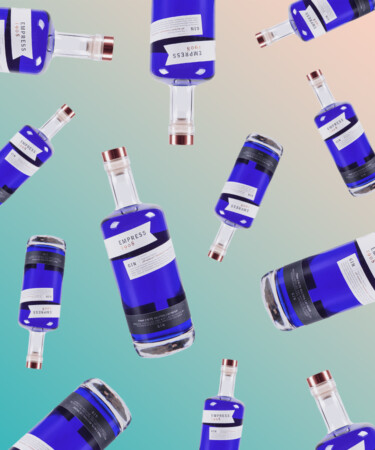Launched in 2017, Empress 1908 Gin has grown to become the No. super-premium gin brand in Canada, achieving over 100 percent growth in 2021 alone. Handcrafted in small-batch copper pot stills by Victoria Distillers, one of the oldest artisan distillers in British Columbia, Empress 1908 combines a unique blend of ingredients, including a black tea blend and vibrantly colored florals, to create a gin that certainly stands out among the rest. Now that you know the basics, here are seven more things you should know about Empress 1908 Gin.
Empress 1908’s signature violet color is all natural…
While one may be inclined to think Empress’s bright violet color is the result of additives or other food coloring, in reality it’s 100 percent natural. The bright violet hue actually comes from butterfly pea blossom, which was chosen by distillers to give the gin deep, earthy notes that balance the traditional citrus-forward flavors in the spirit. The flower providing an eye-catching blue color was actually an unexpected discovery. While testing the tea blend that would make it into the final version of Empress, distillers discovered that the blossom, which is a part of the Blue Suede Shoes tea blend, transmits the purple hue.
As there are no artificial colors added and no stabilizers used in the spirit, every bottle of Empress will begin to fade in color over time. Because of this, the brand recommends finishing each bottle of the gin within one year of purchase and storing bottles in a cool, dark environment as sunlight exposure expedites color fading.
…And it will change depending on what you mix it with.
Butterfly pea blossoms contain compounds called anthocyanins, which change colors depending on the pH level of the substance they interact with. When they are in a neutral environment, like that of gin, they display a bright violet color. When combined with an acidic substance, they will display as red or pink, and when basic, they turn blue. According to master distiller Peter Hunt, Empress’s color-changing abilities were also unexpected. While the team was developing new recipes to feature at Victoria, B.C.’s 2017 Art of the Cocktail, they discovered after making several drinks that cocktails with acidic ingredients, namely citrus juices, had all changed to a pinkish red color while cocktails that had been made with more basic ingredients, like cucumber, had turned a darker blue.
The spirit was inspired by and named after an iconic Vancouver hotel.
The Fairmont Empress Hotel opened on Victoria’s waterfront in 1908 and has served a luxury afternoon tea service ever since, with a revolving selection of seasonally curated hand-picked leaves sourced from all over the world. When creating Empress, the distillers at Victoria Distilling took inspiration from the hotel, deciding to incorporate the legendary tea service as much as possible into their brand’s identity. With that in mind, each batch of Empress 1908 Gin is made with the same black tea blend served at the Fairmont Empress.
Two uncommon ingredients in Empress serve as a nod to India.
Prior to India’s independence in 1950, the country’s residents referred to British kings and queens as Emperor and Empress. In 1877, Queen Victoria, the namesake for Victoria, B.C. where Empress 1908 is made, became the first Empress of India. While Empress was founded and is still produced in Victoria, two uncommon ingredients in the gin — cinnamon and ginger — just so happen to be two of the most popular spices in India and serve as a nod to Canada’s commonwealth sibling.
Empress isn’t afraid to switch up its citrus.
Where most gins on the market use citrus botanicals like lemon or orange in their blends, Empress is made with grapefruit peel instead. According to the brand, the unusual ingredient provides a distinct aromatic experience and slightly bitter, somewhat sweet herbal notes that pair well with gin’s favorite mixer — tonic.
Empress is committed to reducing its footprint.
Aware of the amounts of water and energy necessary to distill spirits, Victoria Distillers is committed to reducing its climate impact wherever possible. As such, the distillery partnered with its neighbor, the Sidney Pier Hotel, to use a closed-loop system during distillation that recaptures heat and water used in the distilling process and transfers it to energy that’s used at the hotel next door. This closed-loop system connects the distillation stills to a geothermal system that powers units used to heat each of the hotel rooms next door. Through this system, Victoria Distillers is able to save approximately 1,500 gallons of water and is able to transfer 850,000 BTUs of energy to the hotel per distillation. Through this project, the distillery hopes to save 1,384,000 gallons of water and transfer a total of over 727 million BTUs to Sidney Pier Hotel per year.
It’s Insta-famous.
Following the release of Empress 1908, violet-hued drinks took the cocktail world by storm and soon enough, you couldn’t step into a cocktail bar without at least one being listed on the menu. As argued by former bartender Joshua Anthony Campell, when cocktails are visually engaging or aesthetically pleasing, it’s more likely that guests will want to order them. This idea was then expanded on by Tarajia Morrell of Zirkova Vodka, who explained to VinePair that the “natural, vibrant violet-blue color of butterfly pea flower is irresistible to bartenders and imbibers from an aesthetic sense.”
